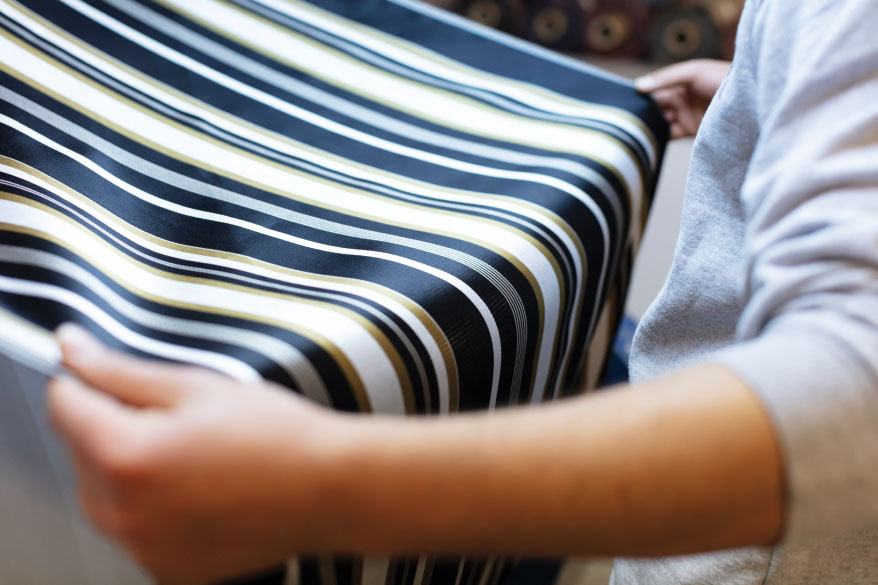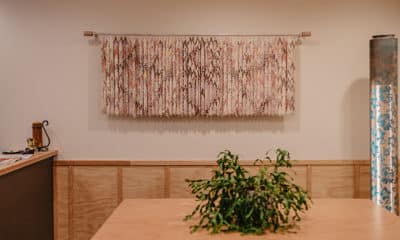WHEN IT COMES to something tactile like fabric, it’s easy to get lost in the hand-feel and look. We interact with fabric every day (from bedding to clothing) and we typically decide what we like based on a visceral reaction. But what does that reaction mean? What are we responding to outside of aesthetics? It’s time to break down fabric types and constructions, flex your technical textile muscle, and discover what qualities will make fabrics successful in your studio – no matter your market focus.
Textiles are often looked at from a perspective of duality and classified into two main categories: knits and wovens. It’s without a doubt the most basic way to break up fabric types, but I’d like to encourage you to start with a broader, aerial view. I’m going to break knits into two distinct categories – circular knits and warp knits – in an effort to recognize both types as the diverse substrates they are, particularly in the digital print arena. Understanding the differences between circular knits, warp knits, and wovens will allow you to choose the best fabric for your project and give you that technical edge your customers crave.
Circular Knits
When you envision knit fabrics in your head, you’re most likely thinking of circular knits. Manufactured by utilizing a circular machine (yes, quite the clever name), circular knits are the apparel power player. Whether it’s the chunky sweater in your closet, your favorite concert T-shirt, or the sweatpants we’ve all been living in during the pandemic, circular knits are routinely used for top-weight garments and rule the activewear and athleisure markets. Within the category there are many types of circular knit constructions from jerseys to interlocks and fleece. (If you want to go deeper on construction types, a simple Google search on “knit constructions” will send you straight down that rabbit hole – same can be done for “woven constructions.”)
When you’re printing on circular knits – especially those with stretch – make sure to be mindful of grin-through (the white lines that come through when the fabric is pulled). Easy fix? Rotate the print 90 degrees and make sure the cut-and-sew team cuts at the optimal orientation. Circular knits can be printed on with several digital textile printing technologies, but dye-sublimation printers traditionally dominate here.
Warp Knits
Warp knits are manufactured in a different fashion on a chain loom where yarns zigzag as opposed to running straight on a circular knit machine. The advantage with warp knits is the inherent construction is much tighter with a locking stitch, making it an ideal fabric to print on. Warp knits are often used for technical garments in high-performance applications like sports and for soft-signage.
If you’re a soft-signage PSP and are unfamiliar with warp knits, it’s time to take notice and contact a fabric supplier to get samples stat. Warp knits provide unparalleled dimensional stability and the constructions are optimal for large-scale photographic printing. In my opinion, it’s the go-to fabric type for signage projects. Most digital printing platforms can print on warp knits, but consult your supplier for specific ink set requirements.
Advertisement
Wovens
Used in the apparel, soft-signage, and home furnishing sectors, woven fabrics are created by lacing two yarn sets, the warp and the weft. Button down shirts, pants, and outwear are usually made from wovens, as are all upholstery fabrics – mainly for durability reasons. When it comes to soft-signage, wovens can be used, but I suggest you do thorough testing on different constructions to ensure high-quality print characteristics. Pro Tip: Be wary of twill weave constructions for signage; it can leave the imagery looking pixelated and out of focus. Many diverse print technologies are used to print on wovens, but, notably, digital pigment printers continue to carve out space in the woven textile landscape.
With so many variables and types of fabric constructions, it’s important to have a working understanding of how each fabric can benefit your project. Take advantage of the great textile resources available and don’t hesitate to pick your fabric supplier’s brain. As for soft-signage, be sure to add warp knits to your lineup and leave the twill weaves to apparel.


 VEHICLE WRAPS + GRAPHICS3 weeks ago
VEHICLE WRAPS + GRAPHICS3 weeks ago
 Press Releases3 weeks ago
Press Releases3 weeks ago
 Case Studies3 weeks ago
Case Studies3 weeks ago
 Case Studies1 week ago
Case Studies1 week ago
 Benchmarks3 weeks ago
Benchmarks3 weeks ago
 Press Releases2 months ago
Press Releases2 months ago
 Press Releases3 weeks ago
Press Releases3 weeks ago
 Press Releases2 months ago
Press Releases2 months ago


















